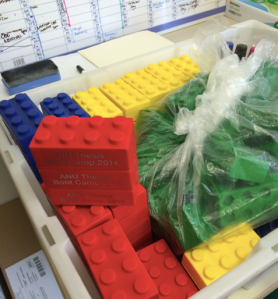One of the most popular posts on the Thesis Whisperer is How to write 1000 words a day and not go bat shit crazy. Last year a Twitter follower brought to my attention a post called How I went from writing 2000 words to 10,000 words a day by the fiction writer Rachel Aaron.
I did a double take.
Can you really write 10,000 words a day? Well, Rachel says she can, with three conditions:
1) Know what you are going to write before you write it
2) Set aside a protected time to write, and
3) Feel enthusiastic about what you are writing
I read the post with interest. Much of what Rachel did conformed with what I suggest in my earlier post, but I couldn’t bring myself to really believe Rachel’s productivity claims. To regularly write 10,000 words: It’s the dream, right? Imagine if you could reliably write 10,000 words a day, how long would it take to finish your thesis… A week? How about a journal paper – a day?
Impossible!
Or so I thought.


The Thesis Bootcamp formula was developed by Liam Connell and Peta Freestone of the University of Melbourne. Thesis Bootcamp (and the veteran’s days which follow) is a total program designed to help late stage PhD students finish their thesis document (In some countries this document is called the ‘dissertation’, but I will use the Australian term ‘thesis’ here). The Thesis Bootcamp concept is simple – put a whole lot of PhD students in a room for a whole weekend and set them the goal of writing 20,000 words each.
Yes – you heard me right.
At every Thesis Bootcamp we have run, at least one student will achieve this goal, and many write many more words than they thought they would. . In this post I want to reflect on Rachel Aaron’s threefold advice and put in the context of thesis writing.
1) Know what you are going to write before you write it
Composing a Thesis requires you to do different types of writing. Some of this writing is ‘generative’ in that it helps you form and articulate ideas by… just writing as much as you can, not as well as you can. It works best when you don’t second-guess yourself too much. The philosophy is ‘make a mess and then clean it up’. Perfectionist writers have a problem doing this, which is why we see so many perfectionists at our Bootcamps.
At Bootcamp we teach our students to focus the generative writing energy to productive effect. An important step in this process is for the student to spend at least a week making a ‘Thesis map’ before they come to Bootcamp. The map is essentially a series of sub-headings which the students use as prompts for composing new text, or re-using existing text.
Students, particularly those in the humanities and arts, tend to agonise over the Thesis document ‘structure’. I think the anxiety stems from the idea that ‘Thesis structure’ is some kind of perfect platonic form they need to discover.
It’s important to realise that structure is made, not found. Thesis structure is strongly influenced by disciplinary precedent and the content of the Thesis itself. A history PhD it might follow a timeline from the past to the present; a science PhD might echo the order of the experiments that have been performed. But multi-disciplinary PhDs, or PhDs in ‘polyglot’ disciplines like education, do not have comfortable traditions. This means you’ll have to make the structure up. Try the following technique:
- Try to capture an overview of the Thesis by completing the following sentences from
- This Thesis contributes to knowledge by…
- This Thesis is important because…
- The key research question is….
- The sub-questions are….
- Decide how long your Thesis will be. Most universities have a maximum word count. Aim for your Thesis to be at least 2/3 of this total (it’s likely you will write more than this, but this gives you some wriggle room).
- Make a document with chapter headings and word counts next to them. Include an introduction of 2000 – 3000 words followed by up to seven chapters of equal length and a conclusion of around 4000 – 5000 words.
- Under the conclusion heading write a rough list of points you think will go in there (hint – these should be answers to the research questions you have posed). Study these closely – have you got data, theories, evidence and arguments to support these conclusions? These concluding points, singularly or in combination, will form the ‘key learnings’ of the Thesis – the knowledge and ideas you want your readers to absorb.
- Each chapter should have at least one key learning in it, maybe more. Under each chapter heading note the key learnings in the form of a brief synopsis of up to 300 words. This synopsis is like a mini abstract that explains what the rest of the chapter will be about.
- Then make a list of the material you will include in the chapter as dot points. Don’t worry about the gaps and stuff you haven’t written yet – just make a note of them. These should be short sentences that will act as subheadings
- Now ask yourself: If, at the end of the chapter, I want the reader to be convinced of the validity of this key learning, what needs to appear first? What comes next? And so on. Rearrange or write new subheadings as you go until you have arranged all the subheadings of the chapter in a way that tells the research story.
Following these steps will help you to create the Thesis map – but it’s important to remember that this is merely an aid to writing, not a plan set in stone. You can change, add and move stuff around as you write.
In our Thesis Bootcamps we ask students to just pick a spot on this map and start writing as fast as they can, not as well as they can. Does this generate perfect thesis ready text? Not necessarily, but many students say that the writing they produce at Bootcamp is clearer than the writing they did before it, when they are worrying over every word. I think the thesis map is a big part of this clarity because it keeps the focus tight.
This organising technique works best for very late stage thesis students, but it can be a way of creating order at any time in your journey and working out what you need to find out or write more about. I’ve made a so you can make one of your own.
2) Set aside a protected time to write
I’ve written so much about this, so I wont rehash it all here. If you are interested in some techniques and ideas for creating protective writing time, have a look at the
3) Feel enthusiastic about what you are writing
I think this is the ‘secret sauce’ in the 10,000 words a day recipe. Rachel Aaron did some deep analysis of her productive writing days and compared these to the occasional not-so-productive days. The days Rachel was able to write 10,000+ words were the days she was writing scenes she had been ‘dying to write’ – she called these the ‘candy bar scenes’. Days where she found it hard to muster 5000 words a day she was bored with what she was writing:
This was a duh moment for me, but it also brought up a troubling new problem. If I had scenes that were boring enough that I didn’t want to write them, then there was no way in hell anyone would want to read them. This was my novel, after all. If I didn’t love it, no one would.
In the fiction world the answer to Rachel’s dilemma was simple – make the boring scenes more interesting! Unfortunately in Thesis World this is not always possible. There will always be parts that are functional and unexciting; I call these the ‘dry toast’ sections – you need to do a lot of unproductive chewing before you can swallow.
There’s a term that describes this process in gamer culture – ‘grinding’. Grinding is being forced to perform the same action over and over again before you can ‘level up’ in the game and get more powers / weapons / armour or whatever. The level up is the pay-off.
One of the most genius ideas Liam and Peta incorporated into Bootcamp was the squeezy lego blocks. We give these out for each 5000 words written in a particular colour order: green, blue, red and gold. The blocks clip together to make a little lego ‘wall’ that the students can display at their writing station. When first presented with the idea of the blocks the students laugh, but all too soon, they are typing furiously with single minded purpose – to get the next block. We have a little ceremony every time someone gets a block, clapping them as they walk up to write their name on the board. It’s cheesy, but it works to turn writing from a source of pain to a celebration. So think about how to reward yourself for every 5000 words written.
Up for the challenge? Have a look at the testimonials on our . I’d love to hear about other ways of doing writing marathons and what you think about this kind of ‘binge writing’.
If you are an ANU student,
If you are in the UK,


I’ve been doing medical writing and translations, and all work comes with tight deadlines, but the normal speed always was 2500 words a day or 10 standard pages. I know people who were able to go up to 4000 words, but quite honestly: how can one be sure about quality of such writing? Is the goal just in quantity or is it in something worthwhile? I’d never believe every single word in a 10K word writing a day is in its right place, or has the shade of meaning which makes any writing unique and worth reading. It’s also physically very tough. After typing some 100 pages in 4 days I was always sick: wrists and shoulders were hurting, and over years my eyesight worsened a lot. Maybe she is dictating this using a voice recognition software? However, that requires a lot of editing. 40 standard pages a day is bit overdone. Just my thou